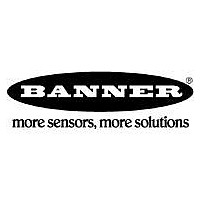SP100R BANNER ENGINEERING, SP100R Datasheet - Page 9

SP100R
Manufacturer Part Number
SP100R
Description
PHOTO SENSOR RECEIVER
Manufacturer
BANNER ENGINEERING
Datasheet
1.MA3.pdf
(20 pages)
Specifications of SP100R
Output Current
150mA
Sensor Output
NPN Open Collector
Supply Voltage Range Dc
10V To 30V
Leaded Process Compatible
No
Peak Reflow Compatible (260 C)
No
FIBER OPTIC Mode
Sensor Hookup Diagrams for MA3-4 MICRO-AMP Modules
10)
The following hookup diagrams include all of the
remote sensors for use with the model MA3-4
modulated amplifier module. It is important to
note how the shield wire of a remote sensor is
wired. The shield wire is the uninsulated wire in
each sensor cable. Failure to connect the shield
as shown may result in false operation of the
amplifier. When wiring emitters, it is good
practice to connect the positive wire first. LEDs
are sensitive to application of the wrong voltage,
and can easily be destroyed.
NOTE: only one sensor may be connected to
each MA3-4 amplifier.
Sensors for use with MA3-4 and MA3-4P Modulated Amplifiers
Sensors are epoxy-encapsulated and optics are hermetically sealed. Cables are 6-1/2 feet (2m) long. 30-foot (9m) cables available by special order.
FOF-400 fiberoptic fitting
glass fiber optics
Models/Dimensions
The threaded barrel design of the
LR400 and PT400 permit the con-
nection of any Banner glass fiber
optic assembly by using two model
FOF-400 fittings. The sensors are
typically mounted through a 3/8
inch (10mm) diameter clearance
hole, with the FOF-400 fittings
threaded onto them after mounting.
Setscrews in the fittings lock the
fibers in place, but allow rapid re-
placement without disturbing any
electrical wiring.
As the excess gain curves show, the
LR/PT400 combination produces a
high-performance fiber optic sens-
ing system. With the amplifier's 1
millisecond response time, this sys-
tem can be used for almost any fiber
optic requirement.
Range: see excess gain curves
Temp. range: -40 to +100 C
LR400 & PT400
with FOF-400 fittings
and fiber optics
Fiber optic information:
IT13S: individual assembly
.06 in. (1,5mm) dia. bundle
IT23S: individual assembly
.12 in. (3mm) dia. bundle
BT13S:bifurcated assembly
.06 in. (1,5mm) dia. bundle
BT23S:bifurcated assembly
.12 in. (3mm) dia. bundle
L9: .5 in. (12mm) dia. lens
L16F: 1.0 in. (25mm) dia.
lens
NOTE: Shield wires must be connected as shown to avoid cable crosstalk.
Hookup of LR/PT200, 250, 300, and 400
E
X
C
E
S
S
G
A
I
N
I
E
X
C
E
S
S
G
A
I
N
E
X
C
E
S
S
G
A
I
N
1000
I
E
X
C
E
S
S
G
A
I
N
I
1000
I
100
1000
1000
10
100
100
10
100
10
.1 IN
10
1
.1 FT
1
.1 FT
1
.1 IN
1
Excess Gain
Opposed mode,
with IT23S
fibers
Retroreflective mode, with
BT13S fibers
Diffuse mode -- range based on
90% reflectance white
test card
with
BP13S
fibers
with IT13S
fibers
with L16F
lens
and BRT-3
reflector
with
L9
lenses
with L9 lens
and BRT-3
1 FT
reflector
1 IN
1 FT
1 IN
DISTANCE
DISTANCE
DISTANCE
DISTANCE
with
BT23S
fibers
LR/PT400
Opposed mode,
no lenses
LR/PT400
LR/PT400
LR/PT400
10 FT
10 IN
10 FT
10 IN
with IT23S
fibers
with
L16F
lenses
100 FT
100 IN
100 FT
100 IN
I
N
C
H
E
S
I
N
C
H
E
S
I
N
C
H
E
S
I
N
C
H
E
S
DISTANCE TO 90% WHITE TEST CARD--INCHES
0.6
0.4
0.2
0.2
0.4
0.6
24
16
16
24
0
0
0
3
2
1
1
2
3
8
8
9
6
3
3
6
9
0
0
0
0
0
Opposed mode
Beam Pattern
LR/PT400
LR/PT400
LR/PT400
LR/PT400
DISTANCE TO REFLECTOR--FEET
OPPOSED DISTANCE--INCHES
(continued on page
6
15
5
IT23S fibers and
L9 lenses
OPPOSED DISTANCE--FEET
1
w/L9 lens
Retroreflective mode,
with BRT-3 reflector and
BT13S fiber
w/IT13S fibers
30
w/BT13S fibers
10
12
2
IT23S fibers and
L16F lenses
Opposed mode
Diffuse mode
18
45
15
3
w/BT23S fibers
w/IT23S fibers
w/L16F lens
60
20
24
4
25
30
75
5
9














